Matador Network's Blog, page 1235
October 23, 2018
Southeast Asia without the crowds
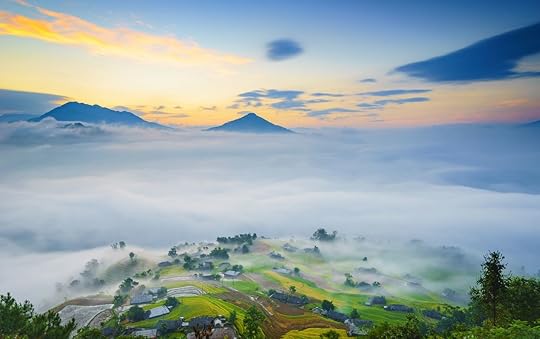
Not long ago, the beaches in Thailand belonged exclusively to Thai fisherman and the ancient ruins in Cambodia were all but hidden by overgrowth. But times change quickly when word of faraway discoveries gets bandied about by budget travelers in search of cheap and enchanting locales. Southeast Asia has long been one such backpacker mecca. On the map for decades now, it has seen those same Thai beaches become the backdrops for drunken ragers and those ancient ruins start trending on social media. But the region takes up a substantial part of the world’s largest continent, meaning there are plenty of spots left to steal away to if you just know where to look.
What is the Banana Pancake Trail exactly?
No one itinerary defines the Banana Pancake Trail, a term derived from the staple breakfast item budget travelers across Southeast Asia are served at the guesthouses and cafes they frequent. The nebulous route started gaining traction in 1975 after Lonely Planet founder Tony Wheeler and wife Maureen published the then backpacker bible Southeast Asia on a Shoestring. The region has since come to be one of the most touristically oversaturated places on the planet.
Eleven countries make up Southeast Asia, but the most popular backpacker haunts have always been Thailand, Cambodia, Vietnam, and Indonesia. Though in recent years, Myanmar and Laos have also joined the ranks. Here are the best places to travel on the Banana Pancake Trail to embrace the backpacker spirit of old while avoiding the tourism hug of death present today.
Thailand
Ko Phayam
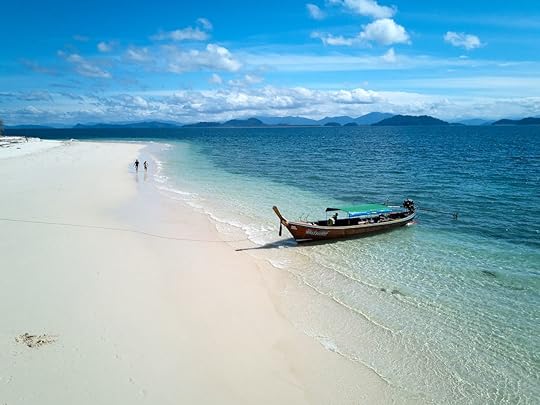
Photo: Toni Schmidt/Shutterstock
Swap the hordes of Full Moon partiers on Koh Phangan for a smattering of in-the-know surfers and you’ve got Ko Phayam. Despite projections that its nearly deserted beaches are next up to be overdeveloped, the second largest Andaman Island still feels wildly undiscovered. And the spotty electricity and WiFi at its unfussy beach bungalows have us pretty convinced that it’s still a ways away from taking up the mantle of resort-laden destinations like Koh Samui.
Nan

Photo: cheewin hnokeaw/Shutterstock
These days, travel bloggers outnumber temples in Chiang Mai, also known as backpacker central in northern Thailand. For a quieter, more rugged window into the Thai highlands, head to Nan near the Laotian border instead. You’ll get your temple fix at Wat Phumin and others. You can start the day at a morning market and end the afternoon opposite waterfalls. And you’ll get a first look at an emerging arts scene by touring the museums and galleries in town.
Koh Mak
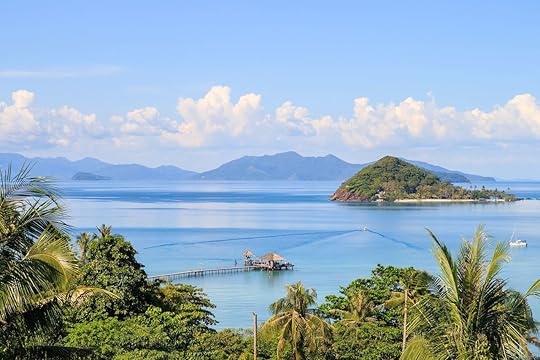
Photo: Phraisohn Siripool/Shutterstock
Koh Mak has the pale sands and bright blue waters you’d expect of a Thai paradise but none of the beer bars and all-inclusive resorts you too often find. It’s popular among families and backpackers looking to avoid the typical circuit, but on the whole, the ratio of palm trees to people still bodes well for serenity seekers. Better yet, all 16 square miles of Koh Mak are privately owned, so it’s in no danger of being built up anytime soon.
Cambodia
Kep

Photo: Mikhail Gnatkovskiy/Shutterstock
Kep is far from undiscovered. If anything, the seaside town in southern Cambodia is on its way to being rediscovered, having once been a haunt for wealthy French colonialists. But the visitors today are neither hoity-toity nor party-hungry, choosing to spend their days at the beach and turning in early after gorging on seafood dinners. For the best of Kep, hit the weekly crab market for $5 pounds of fresh crab meat, then venture into monkey-filled Kep National Park.
Koh Rong Sanloem
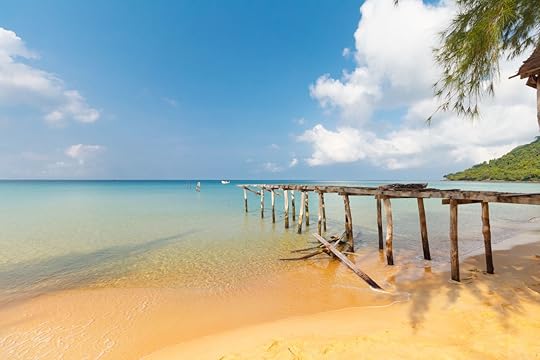
Photo: Jochen Netzker/Shutterstock
Koh Rong Sanloem is not the same as Koh Rong. Write that down if you want a budget getaway without a big backpacker scene because only little sister island Sanloem will deliver. You’re in for a rustic retreat with options to book a dorm by the sea, pitch a tent in the sand, or spring for a simple private bungalow. But the snorkeling and scuba diving are unbeatable, and the trekking and mountain biking are solid. Just be sure to come with cash in hand as you won’t find ATMs anywhere on the island.
Vietnam
Bai Tu Long Bay
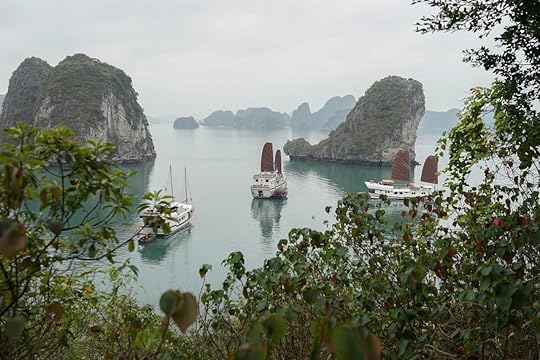
Photo: Jareerat/Shutterstock
Ha Long Bay may have explicit UNESCO status, but it’s also absolutely littered with junk boats. Just northeast and just as stunning, Bai Tu Long Bay belongs to the same World Heritage area and comes complete with the same dramatic karst formations, but its limestone megaliths rise up over uncrowded blue-green waters. There are also caves to explore, fishing villages to tour, and deserted islands to cruise between free from tourist-boat congestion.
Ha Giang

Photo: Nguyen Tien Son/Shutterstock
Ha Giang is as far north as you can get in Vietnam before reaching China. It’s an untouched province where permits are required to travel certain stretches, though these are easy to arrange with most accommodations. Endless rice terraces and rocky outcrops await the intrepid visitors who do find their way here, including the UNESCO-titled Dong Van Karst Plateau. Drive the snaking Ma Pi Leng Pass to get the best eyefuls of scenery during your stay.
Bac Ha

Photo: Asia Images/Shutterstock
Bac Ha is all about that market life. Produce, prepared foods, textiles, and crafts draw huge local crowds from nearby Sa Pa every weekend. Plan to be there on a Sunday to see the Bac Ha market in all its glory and spot the Flower Hmong women whose ornate fashions have become icons of Vietnam. After, head to the Hoang Thu Pho waterfall for a dip in its natural pool or check out Vua Meo, a French colonial palace built in the early 1900s to appease chieftain Hoang A Tuong.
Indonesia
Nusa Penida, Bali
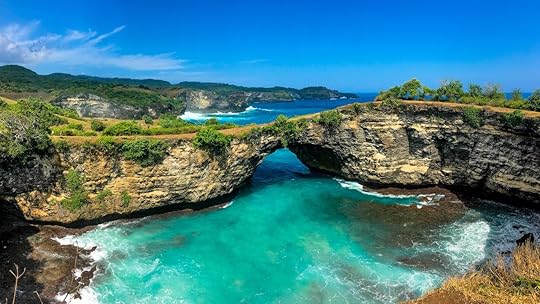
Photo: Glenda Esperida/Shutterstock
Of the three Nusa Islands off the east coast of Bali, only Nusa Penida has even an ounce of off-the-beaten-path appeal left. It’s gotten less hype than Nusa Lembongan and Nusa Ceningan despite its perfect coves, natural pools, and cliffside Hindu temples, in part because of its relative lack of amenities. Unfortunately, the once-ignored escape is becoming a not-so-secret island. Get there now before Instagram influencers completely clog up the scenery.
Bukit Lawang, Sumatra

Photo: AleksSafronov/Shutterstock
On the whole, Sumatra is one of the best ways to visit Indonesia free from mass tourism. And Bukit Lawang is one of its standouts. It is a tourist village, but what that means in the wilds of Sumatra is access to activities like orangutan treks, a comfortable yet unfussy eco-lodge scene, and the slim chance of seeing other travelers while tubing down the river. What it doesn’t mean is luxury resorts, loud bars, or even working WiFi. (Seriously, don’t count on the WiFi.)
Kuta, Lombok
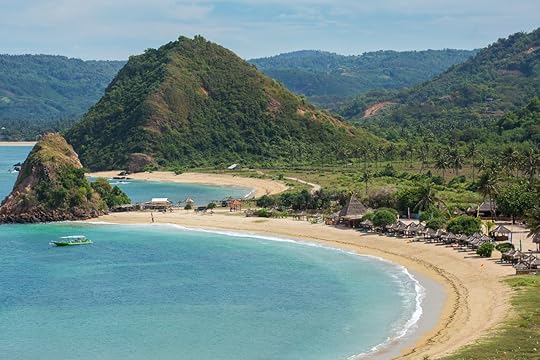
Photo: Alexander Mazurkevich/Shutterstock
Don’t confuse Kuta, Lombok, with Kuta, Bali. One is a lowkey island with just enough places to stay, eat, and grab a beer to strike that perfect balance between backpacker hub and secret hideout. The other is the epicenter of Balinese nightlife that gets treated little better than a frat house. There’s some fear that Kuta, Lombok, will eventually go the way of its club-riddled counterpart, but for now, it’s still a peaceful place to explore by motorbike. To really get away from it all, base yourself near Tampa beach rather than the more popular Mawun beach.
Sidemen, Bali
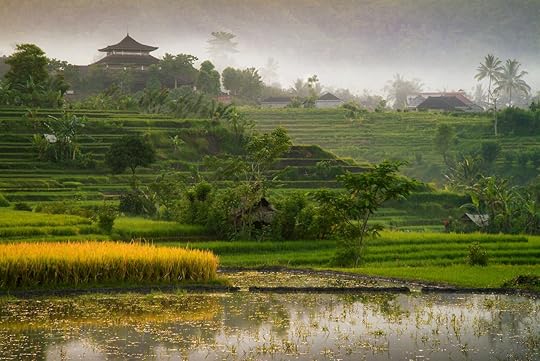
Photo: Edmund Lowe Photography/Shutterstock
If you have your heart set on the rice terraces of mainland Bali but aren’t interested in renting a room in an Ubud guesthouse wedged between an expat-run yoga studio and an LA-style green-drink cafe, then Sidemen is for you. Somehow developers missed this slice of western Bali where the bulk of the action revolves around the daily operations of coffee plantations. Find brilliantly green and thoroughly rural Sidemen under the watchful eye of Mount Agung, about 25 miles from capital city Denpasar, for some genuine peace and quiet.
Laos
Nong Khiaw
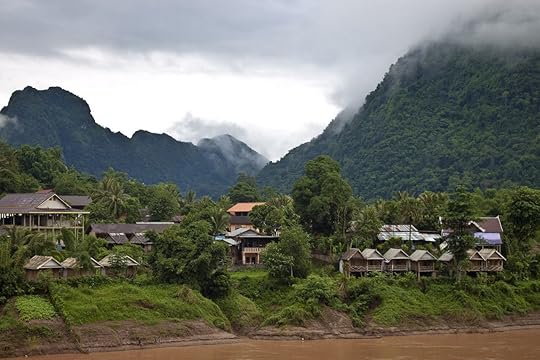
Photo: Matyas Rehak/Shutterstock
Laos is no Thailand, but even its top destinations have been hit hard by tourism. Luckily, the beaten track is still being paved in most of the country, so taking the road less traveled is still pretty doable. One standout is Nong Khiaw, a village north of Luang Prabang known for its cave-dotted cliffs, which cut through snaking rivers and jungles ripe for trekking. A handful of restaurants and accommodations occupy the east bank of the Nam Ou river, some even equipped with infinity pools.
Si Phan Don
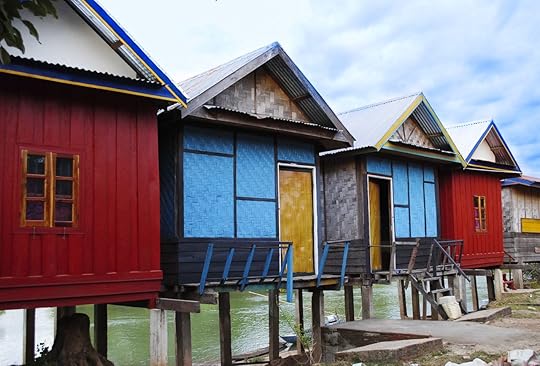
Photo: Kieu pictures/Shutterstock
Surprisingly, little landlocked Laos hosts an archipelago whose name translates to 4,000 Islands. The island cluster in the Mekong is made up of everything from glorified river rocks to wide, beachy expanses. The larger and better-traveled islands — Don Det with its burgeoning party scene and calmer twin Don Khon with its more cultured crew — have bohemian backpacker presences that have not yet reached excessive levels. Still, for the best chance of alone time, set your sights on Don Khong, a quiet island whose relaxed beaches and guesthouses never quite seem full.
Myanmar
Hpa-an

Photo: Cito4ekk/Shutterstock
This mountain town in southern Myanmar isn’t winning first prize in any beauty pageants — though it’s hardly an eyesore — but it could easily claim a Miss Congeniality award. It sits 35 miles north of stupa-studded Mawlamyine and has a salt-of-the-earth vibe that attracts tried-and-true backpackers. Caving and trekking are the activities of choice in Hpa-an, seconded by cultural jaunts to the Kayin State Museum and Kyauk Kalat monastery.
Pyay

Photo: Kanokratnok/Shutterstock
Halfway between Bagan and Yangon sits Pyay, which sees significantly fewer visitors than either despite its ancient ruins and a chill city vibe. Recognized by the World Heritage List, the Sri Ksetra temple ruins in Pyay are some of the oldest examples of Buddhist architecture in the world, and the Shwesandaw Pagoda offers another excuse to visit. Otherwise, there’s plenty of riverside scenery and cliff carvings to sustain a few days in town — and no shortage of comfortable hotels to settle in for the night. 

More like this: The 7 most amazing temples in Thailand outside of Bangkok
The post Where to go on the Banana Pancake Trail that isn’t totally overrun with backpackers appeared first on Matador Network.

Sleep in a dungeon this Halloween
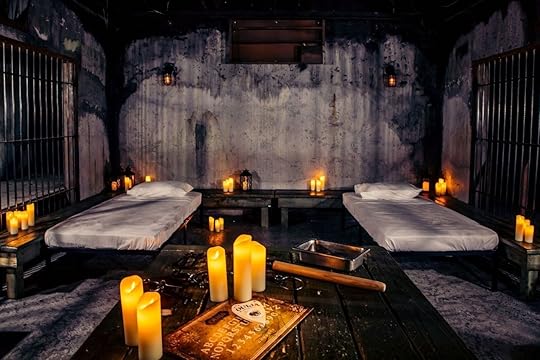
Most nights of the year, announcing to the family you’re spending a night at something called The San Francisco Dungeon might drop some jaws. We’re not ones to judge, but we’re not your parents. But on Halloween, well, it just sounds like one more spooky way to spend the creepiest night of the year and has absolutely nothing to do with ball gags and safe words.
Despite its kinky-sounding name, the San Francisco Dungeon is actually a high-tech tourist attraction at Fisherman’s Wharf, a sort of live-action ghost tour of the city’s past. And next week, thanks to Booking.com, you’ll be able to spend a night sleeping in one of the dungeon’s cells — nicknamed the Alcatraz Suite — for you and one living guest right around Halloween. The number of non-living guests, however, may vary.
Your night will begin with a live performance of the San Francisco Dungeon show, an hour-long walk through the city’s creepy history over the past 100 years with a 360-degree set, an underground boat ride, and an underground drop ride called Escape Alcatraz. It’s part 4D theme-park ride and part live-action interactive theatrical performance, including a dungeon set with impeccable attention to detail.
After the show, you’ll participate in a séance with a real medium, inviting the odd spirit or two to join you in your dungeon cell. You’ll also get your own standard-issue dungeon pajamas, two prison-style mattresses on the floor, candles, midnight snacks, and dungeon toiletries. One of the dungeon’s beleaguered residents will read you a bedtime story before blowing out the lights, after which you’ll sleep in complete darkness until your midnight snack arrives.
You’ll also be awoken with breakfast in bed, which we assume was also what happened at most medieval dungeons after the traditional morning lashing. Assuming you survive, you’ll also get a dungeon schwag bag with stuff like pens and notepads you can leave around your house proudly announcing you’re a patron of The San Francisco Dungeon — which will no doubt be the first thing your next dinner party guests talk about when they get back to the car.
“They seem so normal,” they’ll say. “Never pictured them in latex.”
Perhaps the scariest thing about the dungeon is its price of $66.60 per night. That’s not because it’s the mark of the beast; it’s because any hotel room in San Francisco priced that low is 100 percent possessed by at least three poltergeists — or is actually a cardboard box in the Tenderloin.
Assuming it’s neither, you can book the Alcatraz Suite for Monday, October 29; Tuesday, October 30; or Halloween night on Wednesday, October 31. Parking is not included, which may cost more than the whole experience, depending on which lot you choose. Or maybe take Muni. Whatever your choice, this will be the most unique Halloween night you ever spend at Fisherman’s Wharf — or maybe anywhere. At the very least, it’ll make for some great awkward silences at Thanksgiving when you tell everywhere how much you and Bae loved the San Francisco Dungeon. 

More like this: The 7 most haunted bars in America
The post You can rent a room in a dungeon this Halloween appeared first on Matador Network.

Best budget apps for travelers
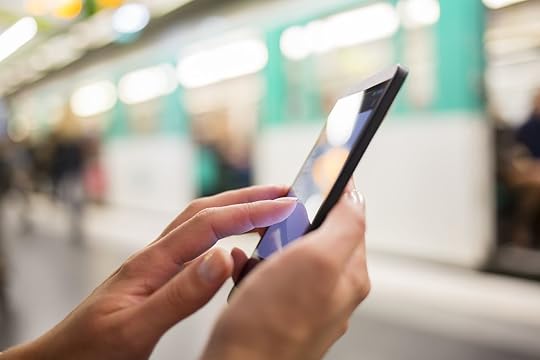
Budgeting for a trip, whether you’re working abroad as a digital nomad or saving at home while drudging through a 9-to-5, can be a bit of a nightmare — especially if you’re the type to lose receipts or simply hate crunching numbers. While some might prefer using Excel to plug in those expenses manually, travelers often need a good mobile app to record what they spend and what to set aside for that next trip. Here are nine budgeting apps for travelers to keep track of their expenses and squirrel away as much as possible to keep on traveling.
1. TrabeePocket
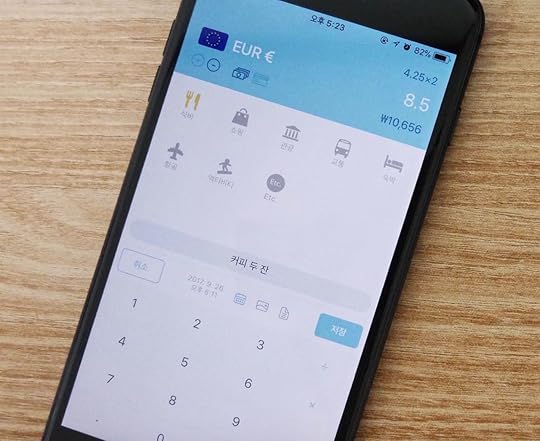
Photo: trabeepocket/Instagram
Not every travel app records purchases in the local currency and differentiates between cash and credit transactions, but TrabeePocket is able to do all that and more. In addition to being a standard currency converter app, you can add images and notes regarding your purchases — just in case you forget which souvenir set you back $100 — and view daily, weekly, and monthly reports.
This app is especially useful for frequent international travelers who work with multiple foreign currencies and have trouble keeping it all straight. It’s available on iOS and Android.
2. Tripcoin
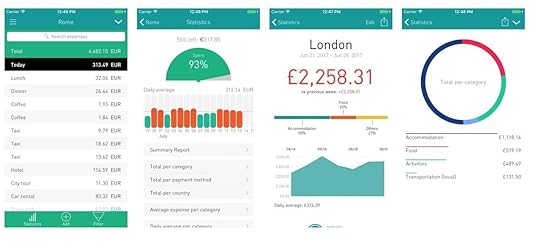
Photo: Tripcoin
This app’s biggest advantage comes from operating without a Wi-Fi or data connection — so it’s very handy for travelers who prefer to enter a new country without a SIM card. Tripcoin’s interface provides bar graphs of daily expenses and charts that can be broken down by country and type of transaction.
A few of the key features include recording the currency exchange rates for the day a user records a transaction abroad, giving a much more accurate count in your currency, and quickly entering expenses — just the type and amount. Only available for iOS users.
3. Spent
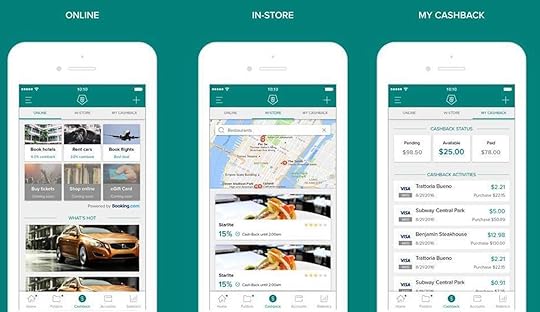
Photo: SPENT/Facebook
Spent can track purchases in much of the same way as other budget apps, but it’s primarily designed to be used prior to a trip in order to take advantage of its cashback and rewards system. The company has partnered with many big brand name stores and hotels, including Airbnb, Uber, and Southwest Airlines, to offer cash back for recorded purchases.
This particular app is useful not for those travelers who save every penny, but for the ones who know which brands are going to get their business and save a little for future trips. You’ll need a PayPal account to make it work.
4. Trail Wallet
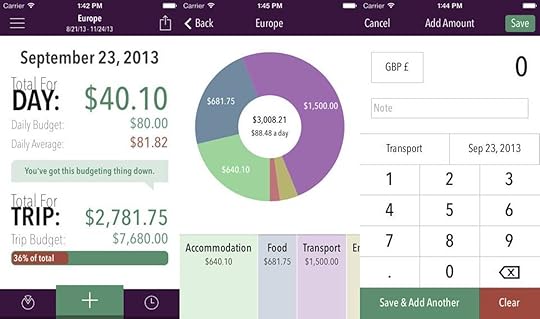
Photo: Voyage Travel Apps/Facebook
This travel budget app was designed by a pair of long-term travelers, so you know they have your best interest in mind. In addition to the street cred of its creators, it has been endorsed by many other travel bloggers over the years, including The Professional Hobo and Nomadic Matt.
With Trail Wallet, you can record purchases in different currencies and display reports. It’s also highly customizable for date ranges, graphics, themes, and sorting expenditures by trip, as well by country. Only available for iOS users.
5. Splitwise
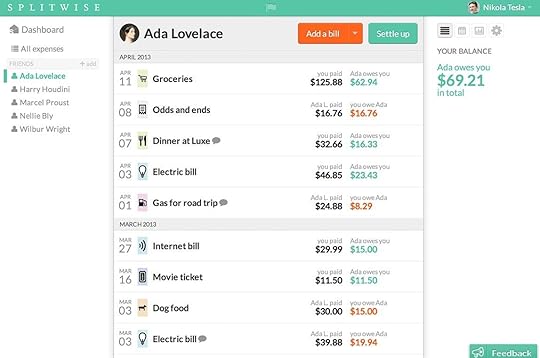
Photo: Splitwise
This app caters to the type of traveler who sticks with groups and mixes finances rather than doing everything independently, but it’s still useful for solo travelers looking to manage their budget. Designed to record what you owe to others, and what they owe you, Splitwise can be used for travelers who split bills and loan others cash.
Unfortunately, as of right now, the app is unable to connect to any bank accounts. Available on iOS, Android, and the web.
6. XE Currency

Photo: XE.com/Facebook
If you have a problem figuring out currency exchange rates on the go, XE Currency will list exchange rates for several different countries (based on the order you chose, or frequency of use). It does require an internet connection for the most recent rates, but can be used offline for the ones last recorded. Available on iOS, Android, and the web.
7. Wally
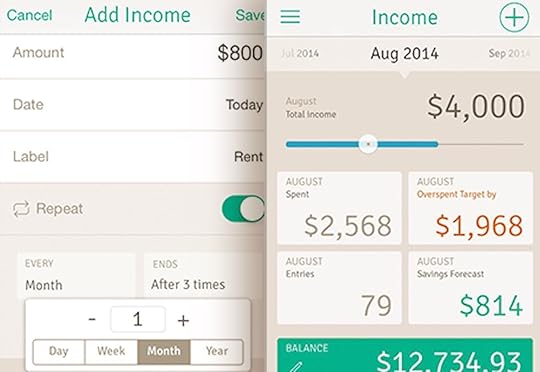
Photo: Wally/Facebook
Set a target number for your savings and watch the app do the rest. Wally is known for its simple display and data entry system — no photos or excessive notes on this app (receipts are allowed), but it’s enough information for you to budget and see how things have gone for the month.
Location tracking and multiple currency options make quick entries of expenses even easier. Available for iOS or Android.
8. Spendee

Photo: Spendee/Facebook
While not designed to exclusively be a travel budgeting app, Spendee works in a similar manner while allowing the user to set savings goals. The interface is very user-friendly, giving a pie chart breakdown of types of expenses.
The app stands out by being able to sync to your normal bank accounts and even incorporate your cryptocurrency accounts, should you be the kind of traveler who relies on Bitcoin or Litecoin. It’s also easy to add transactions quickly, with the option of adding photos and notes later.
9. Mint
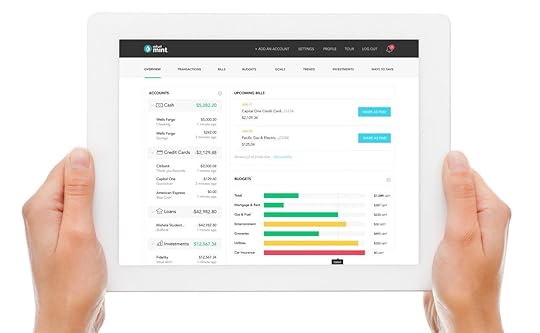
Photo: Mint
Mint is an all-in-one budgeting app. Targeting users in Canada and the US, it tracks both your income and expenses by linking with your bank accounts and updating you on your credit score. The graphics make it easy to see where you are in terms of saving toward your weekly or monthly goals, and how much you have left to spend to hit your target. Travelers can always scale back on Mint’s options by choosing not to sync their accounts and entering everything manually. Available on iOS and Android. 

More like this: The 8 best budget airlines for traveling on the cheap all year
The post The 9 best budgeting apps for travelers appeared first on Matador Network.

World's longest sea bridge open
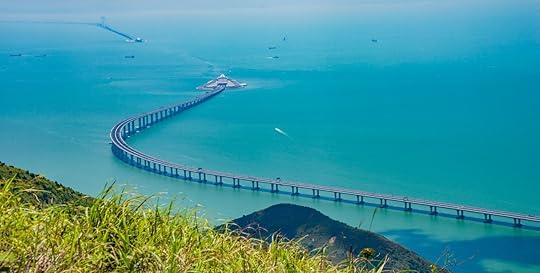
Accessing Macau and Hong Kong from mainland China just got a lot easier, thanks to the opening of this new bridge. Spanning 34 miles, this is the world’s longest sea bridge, and it’s revolutionizing Chinese transportation by linking Zhuhai, Macau, and Hong Kong in just 30 minutes.
It took $20 billion and nine years to build this impressive structure, and it’s expected to be one of the safest, most durable bridges ever built. It was constructed using 400,000 tonnes of steel — enough to build 60 Eiffel Towers — in order to withstand the force of earthquakes and typhoons. It will also be composed of link roads, viaducts, and a middle section that dips into an undersea tunnel to allow ships to pass through.
The bad news for eager travelers is that not everyone can use the bridge. You must obtain a special permit determined by a quota system, and the bridge will not be served by buses or trains. And if you do find yourself crossing the bridge, you’d better make sure you’re awake and alert. According to a local media report, the bridge will be equipped with “yawn cams,” designed to identify drowsy drivers. Yawn three times, and you could actually be pulled over by authorities. It’s also important to remember that when crossing into mainland China, you’ll have to switch sides of the road. People drive on the left in Hong Kong and Macau, but as the bridge is in Chinese territory, merger channels have been built to allow drivers to transition to the right side.
While the bridge will certainly make travelers’ lives easier, it brings its share of controversies. First, the bridge has claimed the lives of at least 18 construction workers who perished on the project. Second, environmental groups are less than enthused about its impact on wildlife. According to the Hong Kong branch of the World Wildlife Fund, the number of dolphins in Hong Kong waters has decreased from 148 to 47 over the past 10 years, and are now completely absent from the area surrounding the bridge. Samantha Lee, assistant director of ocean conservation at the WWF, said, “The project has made irreversible damage to the sea.” 
H/T: BBC News

More like this: The 9 scariest bridges in the world you can walk on — if you dare
The post The world’s longest sea bridge just opened, connecting China, Hong Kong, and Macau appeared first on Matador Network.

SAS Airlines sale today
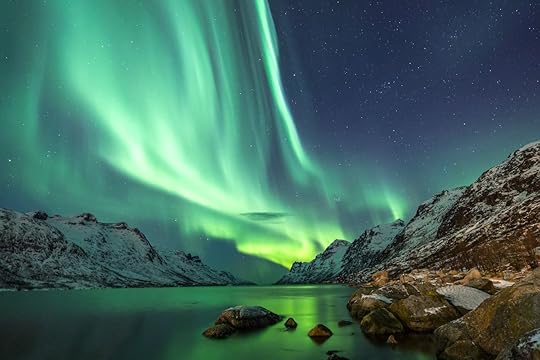
Nobody’s ever confused Scandinavia with a budget destination. Of the 49 European capitals, Oslo, Copenhagen, Stockholm, and Helsinki all rank among the 10 most expensive. And in a land of $8 beers and $30 meals, keeping the rest of your costs down is key.
That’s why a big takk skal du ha is in order for SAS Airlines. Starting today, until October 29th, Scandinavian Airlines will be offering round trips from major US cities to four Nordic capitals; flight dates are from now until June 1st, 2019, for as little as $449.
So if you saw that Finland was one of the best places to travel this December, but felt a little priced out of your northern lights fantasy, now’s your chance to go. Or if you wanted to check out Copenhagen’s Tivoli Gardens in the magic of Christmas, you can put the ticket on your credit card and still have enough left to buy presents for the relatives you actually like.
The sale allows you to travel from today until June 1st, 2019, so if chilling out in eight hours of daylight isn’t your idea of a vacation, you can wait until the weather is a little more hospitable and enjoy the fjords of Norway in late spring. Or enjoy perpetual daylight if you head above the Arctic Circle late enough in May.
The fares vary depending on your destination and where you’re flying from, but not all that much. LAX to Copenhagen and Oslo is $449, Stockholm and Helsinki are $499. Flights from New York or Chicago are $449 to any of the European capitals. Flights from Miami are $499 across the board. And prices fall in the same range for Washington, DC, San Francisco, and Boston — the latter of which gets a new nonstop route to Copenhagen starting June 1st, 2019. You’ll need to go to visit the website for more details, and hit the airline’s low fare calendar to see if the dates you want to go have super-cheap fares.
Now you may say, “$449? Talk to me when you’ve got $99 one-way flights in the height of summer!” And, yes, there are discount airlines who, from time to time, run specials with flights half this price. But they also charge for bags, and unless you’re planning on losing a few toes to the harsh Norwegian winter because you couldn’t stick another pair of wool socks in your carry-on, you’re going to want to pack one. Plus, you get to do crazy stuff like pick your seat and eat during a 14-hour flight on SAS, and will have a seat designed for human beings instead of garden gnomes. Probably worth the extra $200.
These prices aren’t good for every seat on every flight, so the sooner you can get on your group chat and wrangle up a posse to go fjording, the better your chances of nabbing some cheap seats. And the deal is only good until October 29th, so waiting won’t do you much good. Buy this week and your spring break might be cheaper than going to Mexico. 

More like this: 7 epic hotels in Scandinavia with amazing Nordic architecture
The post Scandinavian Airlines is launching an insane flight sale today appeared first on Matador Network.

October 22, 2018
The 10 best food halls in the US

The number of food halls in the US is increasing at a rapid clip. There were just 105 in 2016, and that number is expected to double by 2019. They’re not just in the metropolitan areas where you’d expect food halls to flourish, either. Delaware will soon get its first food hall, as will Boise, Idaho. Three food halls are slated to open by 2020 in Kansas City alone. Food halls are spreading like malls in the ‘80s, but unlike the food courts serving up Panda Express, they emphasize local businesses and diverse cuisine — and they’re a heck of a lot tastier. But while the trend continues to expand, a few food halls stand out from the pack as the ones worth traveling to. From coast to coast, these are the 10 best food halls in the US.
1. The Pizitz Food Hall in Birmingham, Alabama
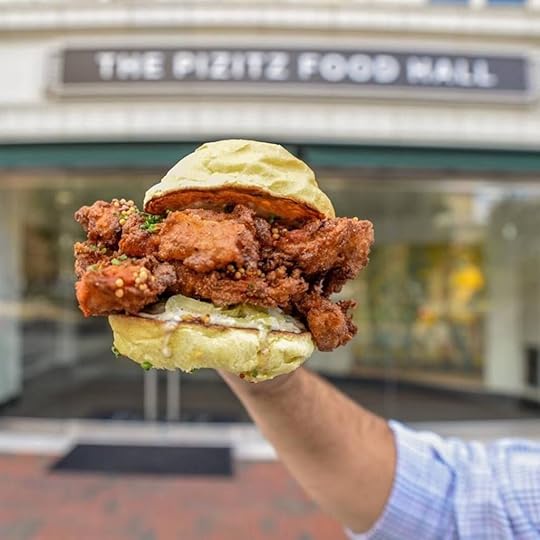
Photo: The Pizitz/Facebook
Birmingham’s nickname is the “Magic City,” and at the Pizitz Food Hall, the magic is all in the food. It shouldn’t come as a surprise that Birmingham makes the list of great food halls in the country. Zagat named Birmingham a rising food city in 2015, and BHam chefs are consistently nominated for prestigious James Beard Awards. Recently, Alabama’s largest city has been in the midst of a major downtown update, and this expansive food hall in a revamped industrial building is a big part of that makeover.
The Pizitz Food Hall opened in early 2017 and has attracted a number of international-minded chefs. There are 15 restaurants with options like Indian street food, Nepalese cuisine, Ethiopian food and coffee, Mexican food, Southern biscuits, and more. The Louis Bar acts as a central meeting point for cocktails and local beer. If you’re looking for something non-alcoholic, the bar has you covered with milkshakes and the South’s favorite ginger ale, Buffalo Rock. There’s a lot to take in with spacious outdoor seating and plenty of room inside for when you want to chow down while avoiding the unbearably humid Alabama summers.
What to eat: This is Alabama, so make your first stop The Alabama Biscuit Company for a Southern biscuit made with stone-milled ancient grain and local ingredients. Ghion Cultural Hall has strong coffee and classic Ethiopian dishes served atop injera (flatbread) made fresh every morning. Visit Mo:Mo: for Himalayan/Nepalese dumplings and Vietnamese banh mis. An incubator kitchen called REVeal Kitchen: The Preservery hosts Birmingham’s rising chefs, with a new group taking over every quarter.
Hours: 7:00 AM – 9:00 PM from Monday to Wednesday, 7:00 AM – 10:00 PM from Thursday to Saturday, and 7:00 AM to 8:00 PM on Sunday
2. Grand Central Market in Los Angeles, California
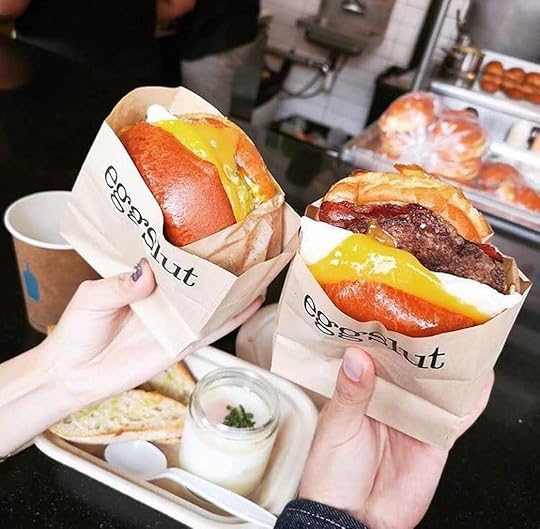
Photo: Grand Central Market/Facebook
There are many great food halls in California — especially in Southern California. You could spend your whole life making stops at places like the new 4th Street Market, Santa Barbara Public Market, and Anaheim Packing House. But that sounds like an incredibly unhealthy and expensive hobby, so focus first on visiting Grand Central Market. It’s the most famous and has been covered by countless publications, but that’s just because great things deserve great attention.
Grand Central Market has been in continuous operation since 1917. It’s changed a lot over the years, just like its surrounding neighborhood of downtown LA has. There were more than 90 vendors back in its early days selling just about anything you could ever ask for. The one-stop feel is the same today with places that focus on just groceries, sweets, or juice. Then there’s the food hall portion. Some 30 food stalls sell everything from breakfast to lunch to cheese, cheese, and more cheese. Come early and stay late — because there’s a lot to take in here.
What to eat: Get the best egg sandwich you’ll ever eat at Eggslut, then stop by G&B Coffee for a hop-infused iced tea to wash it down. Roast To Go has been serving tacos, burritos, and traditional Mexican food since 1952. Sarita’s Pupuseria serves meat and vegetarian pupusas (a Salvadorian dish made from thick corn tortillas filled with whatever delicious option you choose). Homey California-Chinese dishes like wonton soup, fried rice, chop suey, and chow mein are served up at China Cafe. Don’t leave without grabbing some cheese to go from DTLA Cheese and Kitchen.
Hours: 8:00 AM – 10:00 PM every day
3. 1-800-LUCKY in Miami, Florida
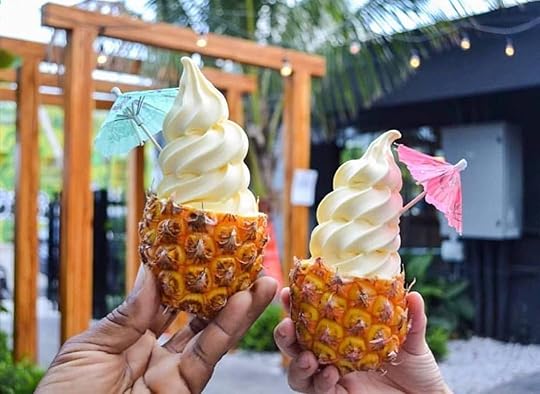
Photo: 1-800-Lucky/Facebook
Florida gets a lot of flak for, well, being Florida. Say what you will about the 67-year-old Florida woman who shoplifts in a turkey costume or the House of Representatives candidate who believes she was abducted by aliens — Floridians know how to build a good food hall. The whole state is filled with them, and trying to pick one is tough. Case in point: Our runner-up pick, La Centrale, is a 40,000-square-foot food hall dedicated to everything Italian. But there’s one food hall that really stands out as being spectacular, and that’s 1-800-LUCKY. Located in the artsy Wynwood neighborhood of Miami, it’s different than your standard industrial-building-turned-restaurant hotspot. It’s a 10,000-square-foot experience with a hip-hop soundtrack, two full bars, a small theater, and a karaoke lounge.
Where to eat: There are seven vendors here, ranging from Vietnamese to Chinese to Japanese to Hawaiian. Les Banh Amis is Miami’s first Vietnamese deli, and it’s doing it right by making everything from scratch — even the liver pate and head cheese. Lotus and Cleaver has Peking duck and wok specialities. For dessert, hit Taiyaki for black sesame ice cream. For the full experience, do karaoke. Drop your fears of being judged for singing and just do it — and order bottle service while you’re at it.
Hours: 12:00 PM – 2:00 AM every day
4. Ponce City Market in Atlanta, Georgia

Photo: Ponce City Market/Facebook
The food hall in Ponce City Market is on the short list of places worth fighting Atlanta’s rush hour traffic to get to. Located in what was once a Sears, the market is the largest reuse of a historic building in Atlanta. To say this place is big is an understatement on the level of saying that Georgia sells a few peaches. The Central Food Hall, owned by the same people behind Chelsea Market in New York City, has attracted James Beard Award-winning chefs Anne Quatrano, Linton Hopkins, and Sean Brock. But you don’t need to be an avid follower of the who’s who in the restaurant world to appreciate all that Ponce City Market has to offer. There are Southern classics, sweet treats, Italian spots, and street food from around the world. Then there are the nearby attractions. A short elevator ride away from the food is Ponce City Market’s rooftop with its 18-hole mini golf course and other games. In the winter, the roof turns into a skating rink. Again, it’s worth the traffic — we promise.
What to eat: Munch on a specialty hot dog while drinking draft cocktails at Drafts + Dogs. Brezza Cucina has a burrata and raw bar menu with happy-hour oysters every day. Miso Ko is a small sushi counter with made-to-order specialty rolls, and if you’re still hungry afterwards, Ton Ton ramen is right next door. Hop’s Chicken is the answer to your fried chicken biscuit cravings, and don’t leave without a drink at the Nine Mile Station beer garden.
Hours: 10:00 AM – 9:00 PM from Monday to Friday, 12:00 PM – 8:00 PM on Sunday
5. Shirokiya Japan Village Walk in Honolulu, Hawaii

Photo: Shirokiya Japan Village Walk/Facebook
Hawaii didn’t need a food hall to get on people’s radars, but the people on the islands have made it a food-hall paradise as well as a, well, actual paradise. Shirokiya Japan Village Walk has every type of Japanese and Japanese-Hawaiian food you could dream of. In all, Shirokiya has 32 food stalls and 14 specialty vendors. There’s a whole section devoted just to food made with Wagyu beef. There are multiple ramen and sushi options, a place for Spam dishes, and a Japanese sweets shop. There’s also international places serving up burgers, Chinese, Vietnamese, and Thai food, and a vintage cave bakery that’s the only place in the country that uses Shirakami-Kodama yeast, which creates an enticing, sweet smell. Afterwards, unwind at the spirit sanctuary with eight buddhas and the 12 animal signs of the Japanese Zodiac — or with $1 beer at the beer garden.
What to eat: The first thing you need to do is head to the Gourmet Plaza and take a long look around. The 14 high-end bistros have plenty of Wagyu, sashimi, and hot pots. After that, listen for the sound of a drum. That means that a batch of okonomiyaki, a fried savory pancake made of cabbage and noodles, is ready over at Takoyaki Yama-chan. Grab a Spam, egg, and avocado sandwich at Musubi Cafe Iyasume because this is Hawaii, and you’re not doing it right if you’re not eating Spam. Wash it all down with fresh juice from the Honolulu Juice Factory or those sweet, sweet $1 beers.
Hours: 10:00 AM – 10:00 PM from Monday to Saturday, 10:00 AM – 9:00 PM on Sunday
6. Latinicity Food Hall in Chicago, Illinois.

Photo: Latinicity/Facebook
Chicago is another city that knows how to make a great food hall, probably because it’s so cold in the winter that your whole group will freeze if you go outside before deciding where everyone wants to eat. You can’t go wrong with places like Revival Food Hall, Foodlife, Super H Mart, or the Chicago French Market. But it’s the Latinicity Food Hall that’s most worth visiting. It’s on the third floor of Block 37, and all of the chefs create dishes with a Latin street food vibe. There are eight kitchens, a Mexican restaurant, cafe, full bar, and lounge. A DJ plays Latin music on Fridays, and there’s a bottomless brunch on Sundays. Yes, bottomless brunch in a food hall.
What to eat: Order ceviche at the Sushi & Ceviche Bar. For something more filling, go to Tortas & Molletes for sandwiches packed with chicken or carne asada, then packed some more with avocado and cheese. Meat lovers should head straight to Saladero Latin Grill for Brazilian steak, salmon, and chicken. Hit the large bar in between meals for takes on mojitos, caipirinhas, Pisco sours, and a long list of tequila and mezcal cocktails.
Hours: 11:00 AM – 8:00 PM from Monday to Friday, 11:00 AM – 3:00 PM on Sunday
7. Indianapolis City Market in Indianapolis, Indiana
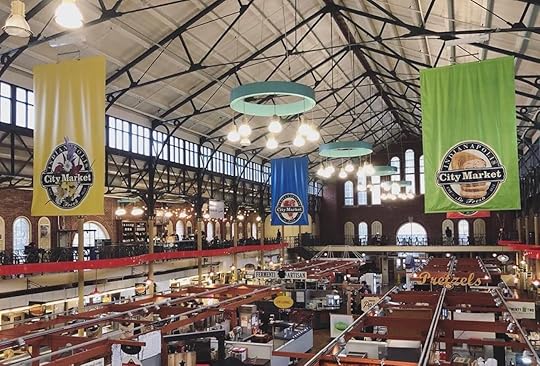
Photo: Indianapolis City Market/Facebook
The Indianapolis City Market first opened in 1886 as a place for farmers to sell meat and produce. It grew over time to include prepared foods and restaurants and is now listed in the National Register of Historic Places. Today, It’s moved beyond what it once was while keeping to its food-centric roots. There are food stalls, specialty coffee shops, a craft beer bar serving only Indiana brews, and, of course, fresh meat and produce. It’s easy to get lost in the lower level while strolling past vendors selling everything from Middle Eastern food to cheesesteaks, while the upper level has drinks and seating.
What to eat: Ditch the meat for a meal at vegetarian hotspot Three Carrots. For a taste of Paris, hit the street-style creperie 3 Days In Paris, which is perfect whether you like your crepes sweet or savory. Gomez BBQ has slowly smoked meats whether your animal of choice is pork, beef, or chicken. Don’t miss The Tamale Place for traditional tamales. Before you leave, sample a beer or three at the Tomlinson Tap Room, which serves beer from great Indiana breweries like Taxman, Bar Hands, and Triton.
Hours: 7:00 AM – 9:00 PM from Monday to Friday, 8:00 AM – 9:00 PM on Saturday, and closed on Sunday
8. Dekalb Market in Brooklyn, New York

Photo: DeKalb Market Hall/Facebook
New York City doesn’t necessarily need food halls. Where food halls have sections dedicated to certain types of food, New York has entire neighborhoods. But if you want to try all that diverse cuisine in one go, head to Dekalb Market. While Chelsea Market in Manhattan gets a lot of attention, Dekalb Market in Brooklyn has far fewer crowds and even more food options. It opened in 2017 and now has around 40 vendors selling everything from Polish pierogies to arepas to kebabs. There are also plenty of dessert spots in the winding food hall, along with micro versions of city staples like Katz’s Deli. And, unlike many of the other food halls in New York City, there’s plenty of seating at Dekalb Market, so you don’t ever have to try and slurp noodles while standing in the middle of a weaving horde of people.
Where to eat: Before strolling around being indecisive about what to eat, grab a beer at Craft + Carry or a glass of wine from Brooklyn Wine Cellar. Grab an arepa from Arepa Lady while you sip, then head to Pierogi Boy for a sampler plate. (Go with friends because it’s a hefty amount of food.) Grab a pickle at Guss’ Pickles as a mid-meal snack then Lioni’s for heroes or Bunker for a banh mi to go. While you’re at it, you can’t go wrong with a key lime pie from Steve’s or a scoop of Ample Hills ice cream.
Hours: 7:00 AM – 10:00 PM every day
9. Legacy Food Hall in Plano, Texas

Photo: Legacy Hall/Facebook
Legacy Food Hall describes itself as “equal parts food hall, beer garden, craft brewery, and live entertainment destination.” If that seems like a lot, consider that it’s a Texas-sized, 55,000-square-feet, three-story venue with six bars and a two-floor brewery. Live bands set the soundtrack, and a slide takes you from the third floor at the top of the brewery to the second-floor bar area. It opened in late 2017 and is expected to one day be the most visited tourist destination in Texas. Don’t let that scare you away, though, because it’s a food haven.
What to eat: If it’s a weekday, make sure your first stop is at the bar for the 3:00 PM – 7:00 PM happy hour. If craft beer is more your speed, grab a brew at Unlawful Assembly Brewing Co. Eat a naan wrap at Blist’r Naan Wraps or go German at Degenhardt’s Brat Haus. Détour wine bar is always a happy stop whether you want a glass or a bottle, and just try to eat only one bao at Enter The Bao. Before you leave, grab a pecan pie (classic, chocolate fudge, or bourbon) at Everett and Elaine Bakery.
Hours: 9:00 AM – 11:00 PM every day
10. Pike Place Market in Seattle, Washington.
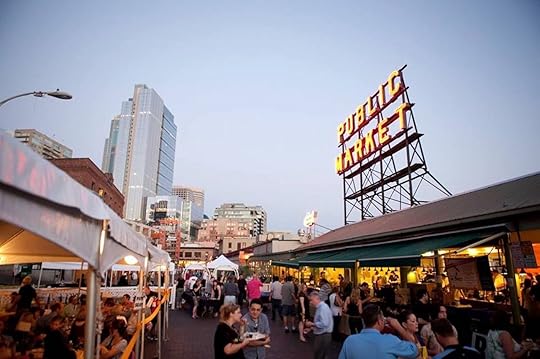
Photo: Pike Place Market/Facebook
The original Pike Place Market opened in 1907, making it one of the oldest continuously operated farmers markets in the US. But this is 2018, and we’re here for the food that’s already lovingly prepared. Located in downtown Seattle, Pike Place is a mix of historic buildings and up-and-coming people in the Seattle food scene. It’s the type of place that you feel good about supporting. It provides services for low-income individuals and acts as a community gathering point with a senior center, food bank, childcare area, preschool, and clinic. Amidst all of that is some of the best food you’ll find in the Emerald City.
Where to eat: Take a dip into traditional Persian food at Farvahar Persian Cafe or hit Kastoori Grill for a taste of the intersection of Indian, Nepalese, and Tibetan food. Pike Place Chowder will cure any rainy day blues, and Radiator Whiskey will heal your soul with smoked meats and house-branded whiskey drinks.
Hours: 6:00 AM – 1:30 AM every day (varies by vendor) 

More like this: 7 destinations you’d never expect to have amazing street food scenes
The post The 10 most epic food halls in the US appeared first on Matador Network.

New nonstop flight from US to Kenya

Layovers can throw a wrench into the smoothness of any trip itinerary. Now, travelers between New York and Nairobi — a long enough journey already — won’t have to worry about stressful connections and painfully boring stopovers. Starting on October 28th, Kenya Airways is offering the first-ever daily nonstop route between the two countries via New York’s JFK Airport and Nairobi’s Jomo Kenyatta International Airport.
“This is an exciting moment for us,” the airline’s Managing Director and CEO Sebastian Mikosz said in a press release. “It fits within our strategy to attract corporate and high-end tourism traffic from the world to Kenya and Africa. We are honored to contribute to the economic growth of Kenya and East Africa.”
The route’s launch is certainly expected to make the country a more attractive tourist destination. It seems to be working, with thousands of travelers hungry for an East African safari adventure already booking their tickets. It will also make it much easier for Kenyans to visit New York City — one of the world’s most popular tourist destinations.
The flight time from NYC to Nairobi will be 15 hours with the return flight taking 14 hours. Currently, most flights take anywhere from 20 to 30 hours, including stops in places like Istanbul, London, or Geneva.
The Kenya Airways flight isn’t the only new flight connecting Africa to travel hubs across the world. Last year, RwandAir launched weekly nonstop flights from London’s Gatwick Airport to Kigali, Rwanda, and intends to offer a nonstop route to NYC in the near future. 
H/T: Lonely Planet

More like this: 25 life-changing experiences in Africa you need to have before you die
The post The first-ever nonstop flight between the United States and Kenya is launching next week appeared first on Matador Network.

Norwegian Pride Hawaiian cruise

Nothing worth doing ever comes easily, which becomes painfully apparent the first time you fly to Hawaii. It’s fourteen hours from the East Coast with layovers, nearly six from the West. And a serious pain from anywhere else in North America. It’s harder for many Americans to get to Hawaii than Europe — and, with its swaying palms, steaming volcanoes, and prohibitively expensive hotels, it may as well be a made-up vacation world that we never get to see.
But if that chance comes to actually make your Hawaiian dreams a reality, you want to see it all. The big city in Honolulu with all its restaurants, cocktail bars, and world-famous beaches; the peaceful, mountainous agriculture of Maui; the moonscapes and steaming volcanoes of the Big Island; the waterfalls and jungles of Kauai. Because when a trip is that long, expensive, and taxing, you’ve gotta treat every day like it’s your last.
Doing this, of course, is a lot harder than suggesting it. Going from island to island is expensive, with fights ranging from $75 to $200. Hotels aren’t cheap. Even if you can afford them, island-hopping means living out of a suitcase or constantly packing and unpacking every couple of nights. Your choices, for lack of anything else, are spending your entire Hawaiian vacation in stressful and expensive transit or picking one island and missing out on the rest.
Or, you can take a cruise.
Cruise-averse people, hear me out. I know for many of you cruising conjures up images of being trapped on a boat full of families in matching T-shirts and not-so-active seniors. And that’s not always inaccurate. But for about the price of a week at mid-range Hawaiian accommodations, you can have your hotel take you from island to island — spending the night in each one and waking up most mornings to a beautiful new Hawaiian paradise.
Your food is included, your views are ever-changing, and it’s the only way to see over half the islands in a week without spending half your time — and money — on planes. And, even if your ship does end up being full of people you’ve spent your life trying to avoid, it doesn’t matter — because you’re rarely stuck on the boat very long. That’s because this cruise is unlike any other in the world.
The most unique cruising experience in America.
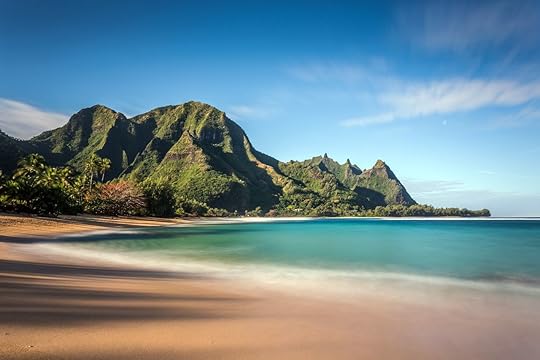
Photo: Pierre Leclerc/Shutterstock
Plenty of cruises hit Hawaii, but for reasons I’ll explain later, they nearly all involve lengthy itineraries with long days at sea and stops in other places. runs an 18-day jaunt that includes a stop in Tahiti. Carnival offers a 10-day trip during which you start in Honolulu and end in Vancouver. But only one ship does a full week in Hawaii with no lengthy sails across the Pacific, and that’s Norwegian Cruise Lines’ Pride of America.
Pride is different than any cruise you’ve ever been on for a lot of reasons, the largest being that it’s the odd boat that’s more about the destination than the ship itself. Not to say that it’s not a modern, clean, well-appointed vessel with great restaurants and plenty of entertainment. But its itinerary is designed to have you spend as much time as possible off the ship, so you can really see Hawaii during your week there.
The seven-day trip stops in four ports with two overnights, enough time for you to do whatever you want without having to rush back to the ship by 5:00 PM. Whereas on some cruises you might have only enough time in port to pick up a hat at the straw market and knock back a few drinks at the closest Señor Frog’s, Pride’s itinerary boasts overnights in Maui and Kauai, as well as two full days on the Big Island in both Kona and Hilo. And it’s the only large-scale cruise ship that’s able to do it all in a week.
Pride can because it’s the only US-flagged ship in NCL’s fleet. While this certainly inspires tear-jerking patriotic pride, it also means that the ship doesn’t need to spend days on end at sea to port in another country. See, cruise ships are allowed to register in any country they like provided they make at least one stop outside the United States. This is why Alaska cruises always stop in Vancouver or Victoria and some Hawaiian cruises sail to Mexico. They do this for a number of reasons, many of which involve complicated US labor laws.
Because is flagged in America, it can run a full week without having to find a foreign land mass, the nearest one being thousands of miles away. The result is a nice, efficient way to see Hawaii that doesn’t eat up two weeks of vacation.
The cruises start around $1,000 per person and go up from there. If you wanted to see even three Hawaiian islands, you’d spend at least $500 just on jumper flights. Add a week’s worth of hotel rooms, and that’s another $1,000 or so, assuming it’s not high season. For two people, you’re out $2,000 before you’ve even looked at a Mai Tai.
That’s not even considering food, which, unless you’re planning to live off spam musubi for a week, can add up fast. The food aboard Pride is surprisingly good, with 19 restaurants onboard, including a steakhouse at Cagney’s with better cuts and service than you’ll find at a lot of land-based spots. So dining on the ship can leave you more money for experiences on the islands. And even if you blow your whole budget on said Mai Tais, you know you’ll never starve.
A perfect week in Hawaii.

Photo: segawa7/Shutterstock
The itinerary starts out in Honolulu with a late departure to give you time to check out the city. The first morning finds you pulling into Kahului, Maui, about a 40-minute drive from the beaches and resorts of Lahaina. You get two days on this island of rolling green hills and expansive farmland, and you can actually rent a car right at the cruise port to explore on your own.
The best exploration will be on the Road to Hana, possibly the most scenic drive in America along the Maui coast. Roadside waterfall hikes dot the landscape as the Pacific Ocean peeks into view around turns through jagged tropical mountains. With two days in port, you can do this drive in one day, leaving the second to do stuff like tour lavender farms, feed baby goats at the famous Surfing Goat dairy farm, and stroll through the historic art village of Paia. With an overnight, you can even splurge on spending the night at a beach resort in Lahaina if you so choose.

Photo: Karen Grigoryan/Shutterstock
From there it’s off to the Big Island and Hilo, the second largest city in the state. Hilo is also the nearest city to the Kilauea volcano that erupted earlier this year, as well as Mauna Kea, the tallest mountain in the world from its base on the seafloor to the top. Though the island has recovered from the eruption, you can still see steam billowing out from the mountains as you drive to Volcanoes National Park. For a bird’s-eye view, you can take a helicopter tour over it all.
The Big Island of Hawaii is, well, big, which is why Pride makes a stop on the island’s west side in Kona the next day. Here you can cruise along the deep black lava fields or dive with sea turtles. With a full day in both cities, you won’t need to do the entire 12-hour drive around the Big Island to really experience both sides — which is another advantage of having your hotel double as your chauffeur.

Photo: DonLand/Shutterstock
The final stop is in Nawiliwili, Kauai. This is the least-developed of the islands you’ll stop on, with a full two days to get out into nature. Float down the Wailua River or head to the island’s south shore and explore the Makauwahi Cave Reserve. Check out Waimea Canyon or use the canyon as a starting point for the Kalepa Ridge Trail to see parts of the famed Na Pali cliffs. Kauai is full of remote trails to tropical waterfalls, most of which won’t be teeming with tourists.
After 32 hours in Kauai, you’ll sail overnight to Honolulu where you can finally check out the ship or just hide in your room and dread the long flight home. For less than the price of a week’s hotel in most of Hawaii, you’ll have experienced over half the islands with a solid amount of time in each one. Even if you don’t love cruising, this is the absolute best way to see America’s 50th state. And it’s an experience well worth the long day of flying. 

More like this: How to choose the right Hawaiian island for your outdoor passion
The post Why cruising is an unexpectedly awesome way to see Hawaii appeared first on Matador Network.

Panorama of Eiffel Tower gone wrong
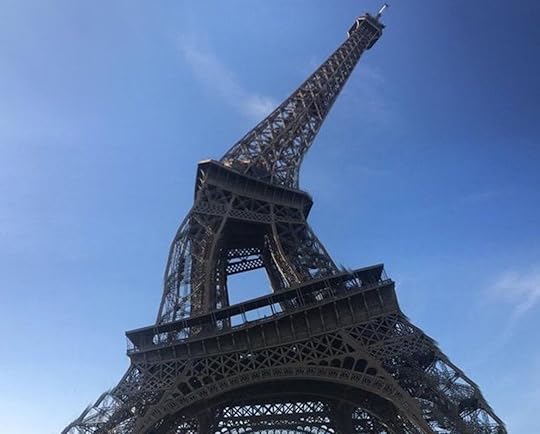
If you’ve ever wondered what the Eiffel Tower might look like if it came to life and drank far too much wine (or absinthe), this photo should give you an idea. Jean-Philippe Dumais, a tourist from Quebec, recently attempted to take a panoramic shot of Paris’ famous landmark that resulted in this Dalí-esque distortion of the tower.
Tried to take a panoramic picture of the Eiffel Tower today, it went surprisingly well! from r/pics
Dumais posted the picture on
H/T: Fox News

More like this: 7 lesser-known Parisian architectural wonders you can check out for free
The post Tourist captures “drunk” Eiffel Tower photo in panoramic shot gone wrong appeared first on Matador Network.

The 9 most colorful neighborhoods in the world
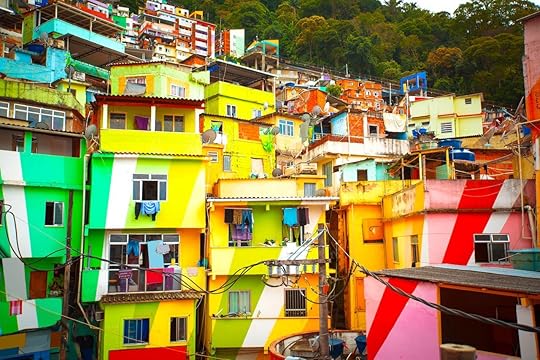
Neutral tones are nice and all, but reaching for a neon or pastel paint can is a surefire way to transform an ordinary structure into a living canvas — just ask these nine dynamic neighborhoods around the world. From a landmark quarter in Turkey to a recently renovated community in South Korea, the following photogenic settlements have taken house painting to a whole new level, proving just how much of a difference a splash of color — or several — can make.
1. Bo-Kaap — Cape Town, South Africa
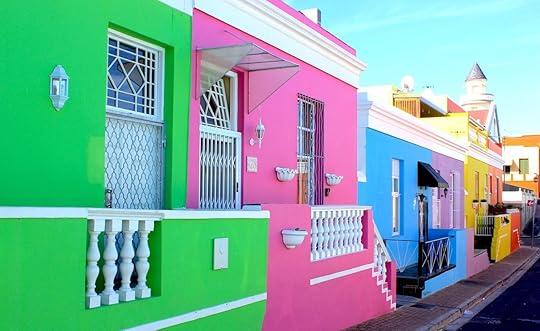
Photo: Janet Newenham/Shutterstock
Formerly known as the Malay Quarter, this vibrant neighborhood overlooks downtown Cape Town at the foot of Signal Hill, a brilliant display of Georgian and Cape Dutch architecture painted every shade imaginable. Its winding streets are some of the oldest in the entire city; the oldest among them, Wale Street, hosts the must-see Bo-Kaap Museum, which delves into the Cape Malay culture and Islamic heritage on which the community was built.
2. Balat — Istanbul, Turkey
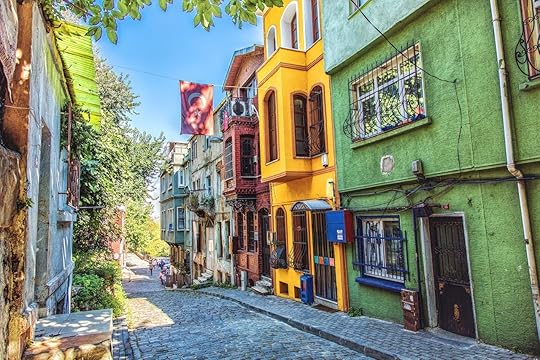
Photo: Lepneva Irina/Shutterstock
The old Jewish Quarter in Istanbul is a whirlwind of colorful architecture where bright pink buildings neighbor electric blue structures. Meander down labyrinthine lanes, discovering Greek Orthodox churches and grand mosques around the corner from artsy, easygoing cafes selling Turkish coffee and local delicacies. Balat and neighboring Fener on the western bank of the Golden Horn might just be the best places to wander aimlessly in all of Istanbul.
3. La Boca — Buenos Aires, Argentina

Photo: Jess Kraft/Shutterstock
La Boca is colorful in more ways than one. Tango music pulses down streets lined with brightly colored buildings, outside of which pickup soccer games are a frequent occurrence. The blue-collar neighborhood has become something of a tourist hotspot with art vendors and cafes on every corner, welcoming out-of-towners without compromising its local flair. Caminito is the beating heart of La Boca, a lively street turned open-air museum filled with lunch and dinner spots that are as well-known for their dance shows as they are for their edible offerings.
4. Punda — Willemstad, Curaçao
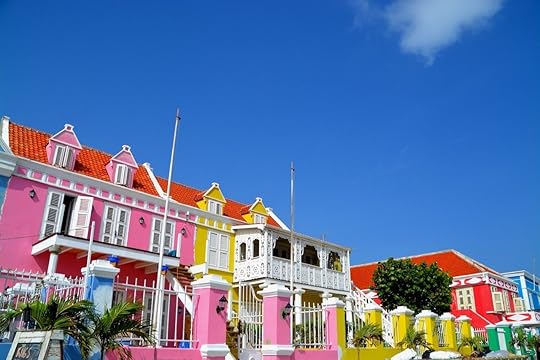
Photo: Styve Reineck/Shutterstock
Punda is one of four quarters that make up the historic center of Willemstad. It’s also the most likely to be featured on a postcard thanks to the Handelskade, a waterfront stretch on the Sint Anna Bay whose colorful properties are more vivid than a box of crayons. The district is home to some of the best dining and shopping on the entire island, as well as an arts scene that will keep visitors very busy. For the best view of the harborfront, snap a photo from the Queen Emma Pontoon Bridge and rake in those Insta likes.
5. Kampung Pelangi — Randusari, Indonesia
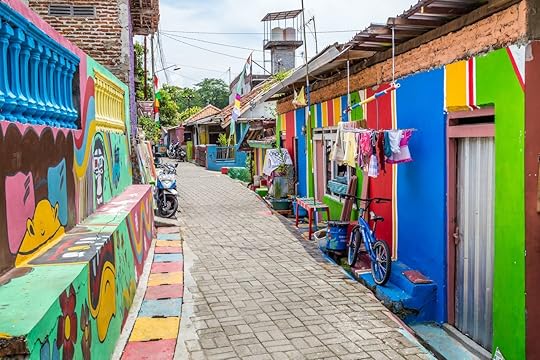
Photo: HildaWeges Photography/Shutterstock
Aptly nicknamed Rainbow Village, this neighborhood in Central Java was painted top to bottom in bright pastels in 2017 in an effort to draw tourism, a hugely successful campaign if social media is anything to go by. Everything from tiled roofs and exterior walls to stairways and handrails are now striped pink, purple, yellow, orange, red, blue, and green. Intricate street art fills the spaces between swaths of paint, leaving very little of the once drab settlement unpainted.
6. Burano — Venetian Lagoon, Italy
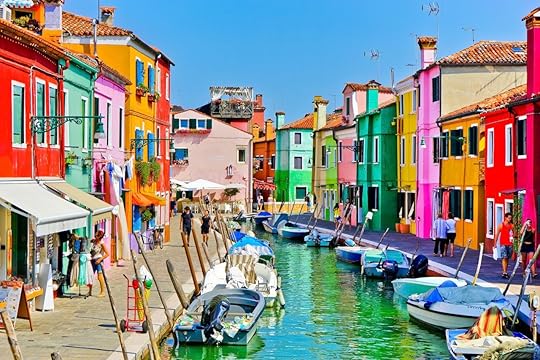
Photo: Javen/Shutterstock
Burano is one of the best reasons to visit Venice outside of its iconic canals and historic plazas. Legend has it that the vivid homes peppering the island were painted to help resident fisherman navigate the waterways on even the greyest of days. No two paint jobs are exactly alike, each more colorful than the next, and behind several lie some of the best seafood spots around. You can visit Burano by way of an easy ferry or water taxi ride from Venice in around 45 minutes.
7. Santa Marta — Rio de Janiero, Brazil

Photo: Skreidzeleu/Shutterstock
You’ll find every color on the spectrum in this hillside favela, in many cases on the facade of a single structure. Santa Marta was first made famous by Michael Jackson after part of the music video for “They Don’t Care About Us” was filmed in the neighborhood. Now known for being the first pacified favela in Rio, Santa Marta draws visitors with its vibrant coloring, which was spearheaded by two Dutch artists who transformed its dilapidated structures into works of art. It’s worth seeing up close, but you should arrange to go with a guide just to be safe.
8. Haight Ashbury — San Francisco, California

Photo: Michael Warwick/Shutterstock
Tie-dye tapestries aren’t the only polychromatic icons of Haight Ashbury, San Francisco’s famous hippie haven. Brightly colored Edwardian and Victorian houses known locally as Painted Ladies can be found throughout the neighborhood, the best known of the bunch being a string of harlequin row houses between Steiner and Hayes Street near Alamo Square. Between gables, window and door trims, and other bright accents, several hues are represented on each Painted Lady, making the Haight one of the most colorful neighborhoods not just in SF but also the US at large.
9. Gamcheon — Busan, South Korea
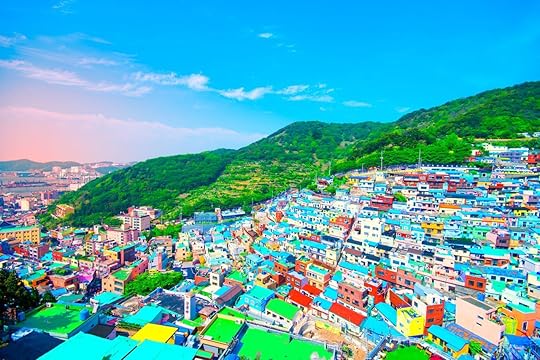
Photo: SAENPHOTO/Shutterstock
Steep, narrow streets wind through the Gamcheon Culture Village in Busan. The historical refugee neighborhood was renovated and given a fresh coat of paint in 2009 to lift local spirits, and it’s been a cultural and artistic hub on the South Korean coast ever since. Kaleidoscopic structures mingle with vibrant murals, decorating everything from alley walls to stairways. There are also tons of cafes and small art galleries to keep visitors entertained while they explore. 

More like this: The 9 most colorful towns around the world you’ve never heard of
The post The 9 most colorful neighborhoods in the world appeared first on Matador Network.

Matador Network's Blog
- Matador Network's profile
- 6 followers



